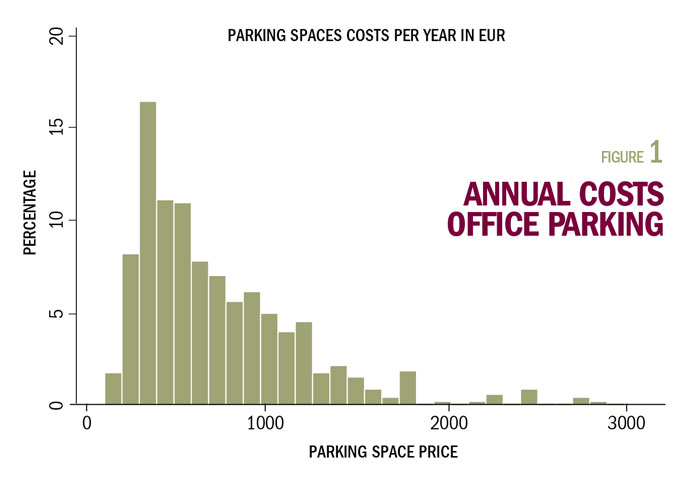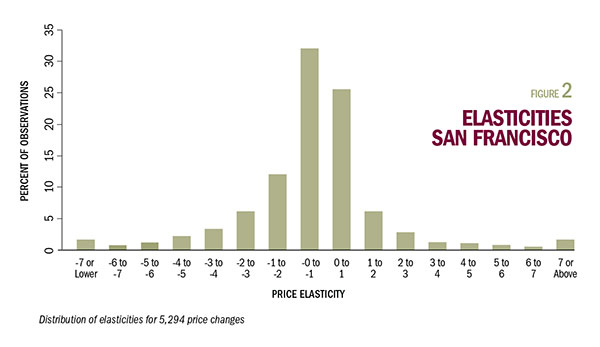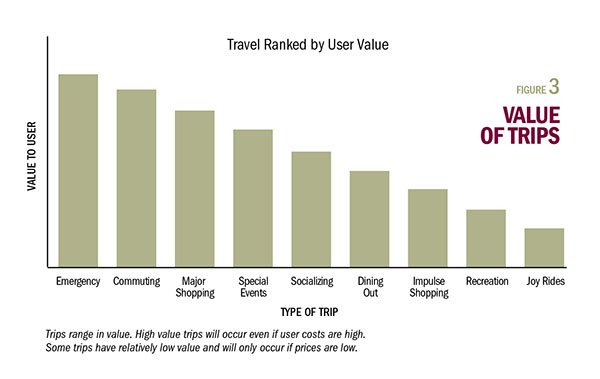The Value of Parking
Many parking-related discussions are about parking fees and about costs of (building and maintaining) parking facilities. The importance of parking is widely recognized, but car drivers are reluctant to pay even a small amount of money for parking. But when paid parking is introduced or parking fees are increased, it appears that the price-elasticity of parking demand is low.
In the heated debate about parking you will find on one side the representatives of retail-organizations, proclaiming that every cent spent on parking fees is too much and is chasing customers away. At the other side of the spectrum there will be parking operators declaring that free parking does not exist, and that parking fees are necessary to achieve a profitable business result.
Very few of these discussions are based upon research-supported facts. That is not so strange; quantitative research on this matter is rather scarce, and the results are not generally known.
This article will give some research-funded food for thought on the value of parking.
What’s a parking-space worth?
In the Netherlands Van Ommeren has researched the hidden costs of parking. He analysed prices for residential properties with or without a private parking space and thus found that in residential areas with paid parking the value of having a private parking space could be calculated at € 16.000. This means that these residents are paying more than € 1 per day for not having to look for an available (paid) on-street parking space. In areas with a system of residential parking permits, which know long waiting lists for obtaining a permit, the value of having one’s own private parking space can increase to nearly € 40.000. Residents who are prepared to invest this extra amount in buying a house with its own private parking space thus pay € 8 per day for avoiding the waiting list, much more than the price of a residential permit (the prices for residential permits vary from € 0.065 to € 1 per day!).1
He also found that offices are prepared to pay an average of € 785, annually for every parking space they offer to their employees (figure 1). In the annual running costs of an office parking is responsible for 8.8% of the total costs. These costs are usually paid by the companies, and not by the users of the parking spaces, the employees. When these costs would be charged to the employees parking demand might decrease with some 30%.2 His conclusion is that offering free, or below-cost, parking to employees leads to extra parking demand.
Price-elasticity of parking demand
Parking fees are an efficient way of regulating parking. Offering free parking will lead to undesirable effects. Free parking does not benefit retail, because it will lead to a decrease of parking opportunities for customers (e.g. Oslo, and recently Holywell, Wales). Neither will it attract new customers; shopping decisions are made based on other criteria like retail supply and a pleasant shopping environment. Nor does it benefit the parking operator (obviously) or the municipality, that will be confronted with the parking-chaos of unregulated parking.
The pivotal point in this is the low elasticity of parking demand. Parking demand in general is inelastic; this means that the percentual change in parking demand will be smaller than the percentual change in parking fees. (|elasticity |<1). Practically all studies into the price-elasticity of parking demand result in (empirical or calculated) values in the range of -0.1 to –0.6, with a global average of -0.3.3,4,5 This can be explained by the fact that traffic (and parking) are in fact an indirect demand (caused by social-economic structures)6. That is why in most traffic and transport sectors often inelastic demand functions are found.
The BTE Transport Elasticities Database offers an overview of world-wide sources for the price elasticity of parking demand, which are generally in the order of -0.37. The BTE database gives also, based upon studies in British towns and in Portland, Oregon, the indication that the sensibility for price-changes increases with longer parking duration. This might imply that not only the percentual change, but also the absolute (increase of) the amount to be payed plays a role.
Literature indicates that there is a difference in price elasticity between short term and long term effects. Car drivers can adapt their long term behaviour more easily than change their habits on short notice. Long term effect therefore can be more elastic than short-time affects6,8.
Commuter traffic
The majority of studies on price-elasticity deal with commuter traffic. The number of travellers, and the time they will be staying will not change much. There may be a cross-effect in modal split [4]. A number of studies showed (with a price-elasticity) a decrease of car use (on average from 72% to 53%, a decrease of 19%).9
The main effect of price changes in parking fees for commuters is that car drivers will try to find alternative locations for parking. A minority will consider a modal shift or not making the tripo at all 10,11.
Shopping trips
For shopping trips generally a price-elasticity of parking demand in the order of -0.3 is found (when parking fees are raised by 10% this will result in a 3% drop in parking demand). Results are more varied then for commuter parking, partly because customers have more options (change travel mode or destination, but also changes in frequency of visits, or parking duration are possible). In Dublin for instance research showed a lower elasticity for parking frequency (-0.11) than for parking duration (-0.20). This shows that some car-drivers react by shortening their stay after a price-increase.10
Especially for parking in city centres price-elasticity is influenced strongly by factors such as location, time, quality of the city centre and motive for visiting. For that reason it is nearly impossible to find one general price-elasticity for parking demand in shopping and city centres. This became obviously clear recently in the evaluation of the system of variable pricing for parking in San Francisco12. In a considerable number of cases an increase of parking-fees was found to be followed by an increase of parking demand! (Figure 2)
The value of parking
Price-elasticity for parking demand is strongly connected to the value the car driver puts on certain types of trips (cross-elasticity). Highly valued trips will still take place, even when the price is high (low elasticity). When the added value of a trip is considered lower, a driver may sooner skip the trip or find another solution (higher elasticity). An indication for this connection between the value of an activity and the value of the trip/ parking has been given by Litman (figure 3) 11.
This is the crucial aspect in the discussion about price-elasticity and parking fees. The value of a trip, including parking, is not determined by the value the car driver attaches to parking in itself, but is determined by the value that is connected to the activity, the trip-motive, that can be reached by parking. Parking in itself is not the motive; the car driver sees parking as an inconvenience, a necessary activity and a necessary expense to be able to perform an activity that is valuable for her/him. Parking in itself though has no added value for the customer, the added value the driver experiences lies in the activity that can be done thanks to the availability of parking capacity. Discussions about parking fees are therefore in fact not about the level of parking fees, but they are about the fact that you have to pay for something that in itself has no value for the visitor.
For car drivers parking has a price, but no (added) value.
By Sjoerd Stienstra (stieverk@wxs.nl)
References
- The real price of parking policy; J.N. van Ommeren, D. Wentink, J. Dekkers, Journal of Urban Economics, Den Bosch, 2011
- The (hidden) cost of employer parking policies; Jos van Ommeren, Derk Wentink, VU Amsterdam, 2009
- Traveler Response to Transportation System Changes Handbook; TCRP report 95, Transportation Research Board, Washington DC, 2005
- Australasian travel demand elasticities- an update of the evidence; Ian Wallis, Natalie Schmidt; Booz Allen Hamilton, Wellington (Nw. Zeeland), 2003
- Assessing the potential for road and parking charges to reduce demand for singrle occupancy vehicle commuting in the greater Vancouver regio; Kevin Fredrick Washbrook MA; Simon Fraser University, 2002
- A survey of recent estimates of price elasticities of demand for transport; Tae H. Oum, W.G. Waters II, Jong Say Yong; Working paper WPS 359, Infrastructure and Urban development dept., The World Bank, 1990
- Transport Elasticities Database; Bureau of Transport Economics, Australië (http–www.bitre.gov.au-tedb-tableList.aspx/)
- Etterspørseleffekter på kort og lang sikt: en litteraturstudie i etterspørselsdynamikk; Nils Fearnley, Jon-Terje Bekken; TØI rapport 802/2005, Oslo, 2005
- Traveler Response to Transportation System Changes Handbook; TCRP report 95, Transportation Research Board, Washington DC, 2005
- Temporal variance of revealed preference on-street parking price elasticity; Peter J. Clinch, Andrew Kelly; Planning and Environmental Policy Research Series (PEP) Working paper 04/02, Dept. of Planning and Environmental Policy, University College Dublin, 2004
- Transportation Elasticities, How Prices and Other Factors Affect Travel Behavior; Todd Litman; Victoria Transport Policy Institute, Canada, 2005
- SFpark: pricing parking by demand; Gregory Pierce, Donald Shoup, Parking Trend International 2014/1








